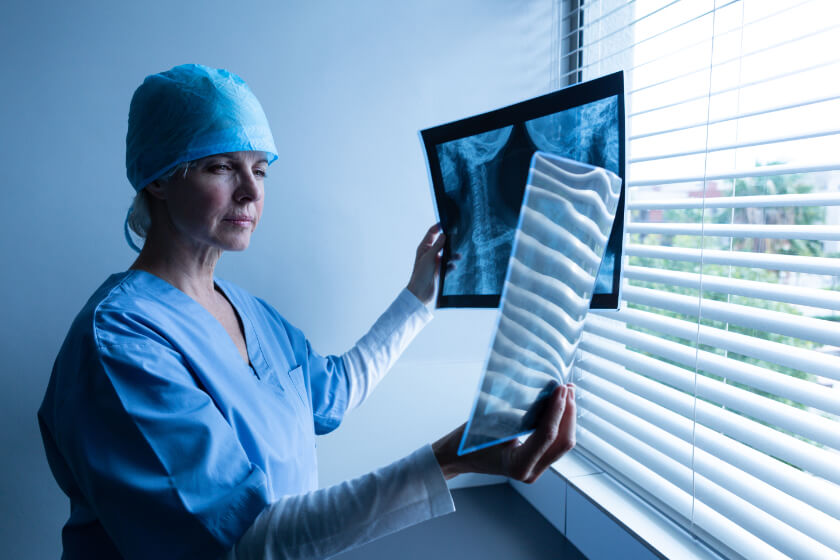
Who (or What) is Aunt Minnie?

Nearly every profession has its own trade lingo. Musicians say “one-four-five with a short four” to refer to different notes on a major scale, for example, and a movie director might say “chicken in the gate” at the end of a take. Radiologists also have their own lingo.
One of the most famous is Aunt Minnie. In fact, Aunt Minnie is so renowned among radiologists that the world’s largest and most comprehensive community website for medical imaging professionals is named www.auntminnie.com.
So who is Aunt Minnie? The better question might be, “What is an Aunt Minnie?”
The Story behind Radiology’s Aunt Minnie
Dr. Benjamin Felson was a radiology lecturer and an expert in interpreting x-rays who practiced in the mid 1900s. He often amazed patients and doctors by making a complex diagnosis simply by looking at an x-ray image, according to an NPR interview with radiologist Harold Friedman.
When lecture attendees and others asked Dr. Felson how he could make a diagnosis in a glance, he said it was like seeing his Aunt Minnie. When he saw Aunt Minnie at the door, for example, he didn’t see her as an old lady with white hair and a slight limp – he knew it was Aunt Minnie the moment he laid eyes on her.
Dr. Felson would go on to say that an “Aunt Minnie” is “a case with radiologic findings so specific and compelling that no realistic differential diagnosis exists. In other words: If it looks like your Aunt Minnie, then it’s your Aunt Minnie.”
“Aunt Minnie” is a radiologic finding so specific and compelling that there is no question about the diagnosis.
While Dr. Felson popularized the phrase in his 1960 classic textbook Chest Roentgenology and in his lectures, Chief of Radiology at Boston Children’s Hospital Ed Neuhauser actually coined the term. Neither Dr. Felson nor Dr. Neuhauser had an Aunt Minnie.
Both used the phrase to describe a radiology image so classic that once a radiologist sees it, he or she will never forget it. In other words, when Aunt Minnie enters a room, you know who it is even though you don’t see her every day.
So, did Dr. Felson have a special gift for spotting Aunt Minnie? Probably not. Ben Felson attended the University of Cincinnati and earned his MD in 1935. He then worked at the Cincinnati General Hospital, first as an intern and then as a radiology resident, which was a 3-year course at the time. Felson then completed a 1-year fellowship in cancer therapy at the Indianapolis City Hospital. After several years as a practicing radiologist, Felson gained fame as a dynamic, informative, and entertaining radiology lecturer. Listeners admired his ability to spot Aunt Minnie and the often envied the spontaneity of his talks. It turns out that he worked very hard in his studies of radiology and even rehearsed his spontaneity. Felton even took classes in the University of Cincinnati’s department of education to learn how to teach others about radiology and spotting Aunt Minnie.
Aunt Minnie has aged well
Throughout the years, countless radiologists have spotted Aunt Minnie in their daily practices.
In 1999, two doctors published an example of an Aunt Minnie in which a pediatrician had suspected a child of having been battered. The doctor took a series of x-rays of the child and showed them to a radiologist. The radiologist looked at the x-rays and told the doctor that the child had leukemia. The doctor protested, saying that the child’s blood tests were normal. The radiologist shrugged and said, “It’s an Aunt Minnie.” Several weeks later, a repeat blood test confirmed that the child had leukemia.
Seeing Aunt Minnie is not always a bad thing, though. Experienced radiologists can often tell the difference between a serious problem and something harmless. In many cases, seeing Aunt Minnie at your doorstep is a good thing.
Radiologists look at hundreds of x-ray, CT scan, MRI, and ultrasound images over the course of a week – or even in a day! So how do they sift through all of the normal “negative” images to find the sometimes small but very significant anomaly that indicates a problem? Training, experience and advances in technology help radiologists spot Aunt Minnie when she shows up at their door.
Advances in technology and training help radiologists see Aunt Minnie everywhere, in x-rays, CT scans, MRIs, and ultrasounds. Experience and training helps radiologists recognize “good” Aunt Minnies and “bad” Aunt Minnies at a glance. Putting these technological advances in the hands of highly trained and experienced radiology professionals yields more Aunt Minnies than ever before.




